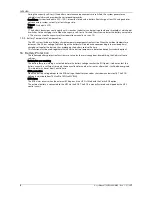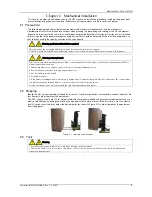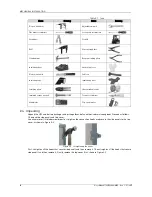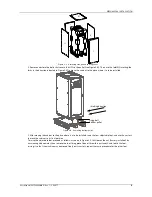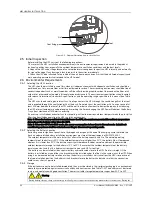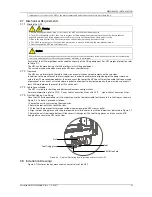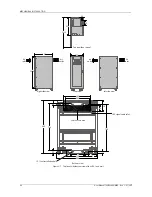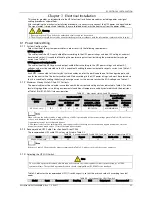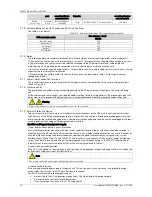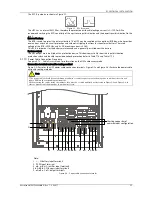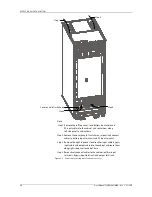
OVERVIEW
User Manual 10H52246UM60 - Rev. 1 - 01/2017
11
1.2.2
Bypass
The 'Static Switch' module (as shown in Figure 1-1) contains the controllable electronic switch, and features an
intelligent control system that enables the loads to be supplied by the inverter or the bypass. Under normal
conditions, the loads are supplied by the inverter, and the automatic inverter switch on inverter line is closed. In the
event of an overload (the overload delay time expires) or inverter failure, the inverter switch is opened, and the
'Static Switch' module transfers the loads automatically to the bypass.
Under normal operating conditions, the inverter output must be synchronized with the bypass in order to ensure
that the load is transferred from the inverter to the bypass without interruptions.
Therefore, when the bypass frequency is within the synchronization range, the inverter control circuit will
synchronize the inverter output frequency with the bypass frequency and phase.
The UPS is also equipped with a manual maintenance bypass switch, which is used to de-energize the UPS during
maintenance work. In this condition, the bypass supplies the critical loads directly via the maintenance bypass line.
Note
When the load is supplied by the bypass or maintenance bypass, the quality of the power supply is not guaranteed.
1.2.3
System Control Principle
Normal operation
In normal operating mode the UPS mains input is within the acceptable limits, the rectifier and inverter are
operating normally, the load is supplied by the inverter, the battery circuit breaker is closed, and the battery is in
stable floating charge state.
(Parallel System)
Note: As the individual UPS module outputs are connected in parallel, the system checks that
the inverter control circuits are perfectly synchronized with one another, and with the bypass, in terms of both
frequency and phase, and that their output voltages are the same. The current drawn by the load is divided
automatically between the UPS modules. A warning message appears while synchronization is in progress.
Abnormal mains
When the mains supply fails or goes outside the acceptable limits, the rectifier switches off automatically, and the
system transfers to battery output (via the inverter). The length of the operating time in battery mode depends on
the load and the battery capacity. During this period, if the battery voltage falls to the EOD voltage and the mains
supply has not yet returned within acceptable limits, the inverter switches off automatically, and the UPS operator
control and display panel display the corresponding alarm messages. If the system uses a separate bypass
configuration, and the bypass supply is normal, the system transfers to the bypass line
Mains recovery
When the main input returns within its normal operating limits inside the acceptable time interval, the rectifier
restarts automatically (at this point its output power starts to increase gradually), supplying the load and charging
the battery again. Therefore, the power supply to the load will not be interrupted
Disconnecting the battery
If it is necessary to disconnect the external battery when carrying out maintenance work, use the external isolating
switch. In this condition, the steady state performance of the UPS is not affected and all its functions are
guaranteed, with the exception of the battery backup supply in the event of a mains failure.
UPS module failure
In the event of an inverter failure, an automatic inverter switching failure, a blown output fuse or a bypass STS
failure, the load is transferred automatically to the bypass supply line, without interrupting the power supply to the
loads. If any of these fault conditions occur, please contact your local Vertiv customer service center for technical
support.
(Parallel System)
If one of the UPS modules fails, it exits the parallel system automatically. If the system is still
capable of providing the required power, the remaining module continues to supply the load without interruption. If
the remaining modules are no longer capable of fulfilling power requirements, the load is transferred automatically
to the bypass line.
Overload
If the inverter is overloaded or the inverter current remains outside the specifications (refer to Table 11-6) longer
than the specified time, the load is transferred automatically to the bypass without interruption. If both the overload
and the current return to a level within the specified range, the load is transferred back to the inverter. In the event
of an output short circuit, the load is transferred to the bypass, and the inverter is shut down. Five minutes later, the
inverter restarts automatically. If the short circuit is no longer present, the load is transferred back to the inverter.
The transfer is determined primarily by the specifications of the system protection device.
In the two situations described above, alarm messages appear on the UPS operator control and display panel.
(Parallel System)
The logic control system monitors load requirements constantly and controls the power supplied
by each UPS module. In the event that an overload condition persists for longer than a preset interval, and the
number of active modules is unable to satisfy the load power requirements, the load is transferred to the bypass.
The load is re-transferred to the inverter if the power requirement is reduced to a value that can be supplied by the
number of active modules remaining in the system.
Maintenance bypass
The UPS is also equipped with a maintenance bypass circuit, which provides a safe working environment for the
engineers when carrying out maintenance work or repairs on the UPS system, while supplying unregulated mains

















